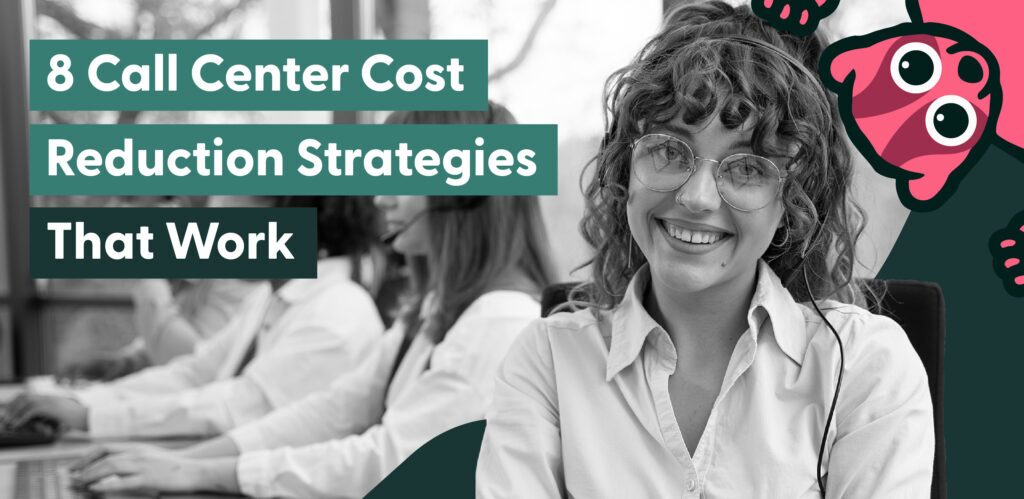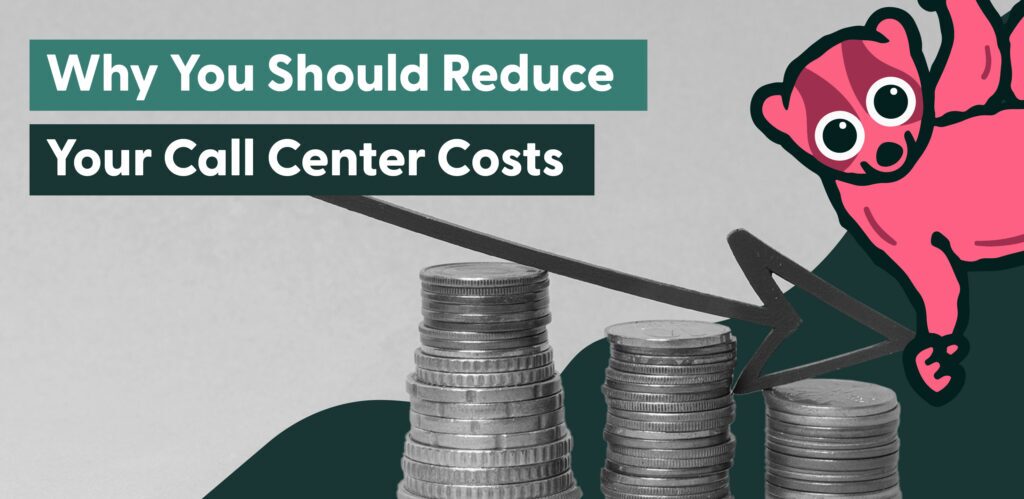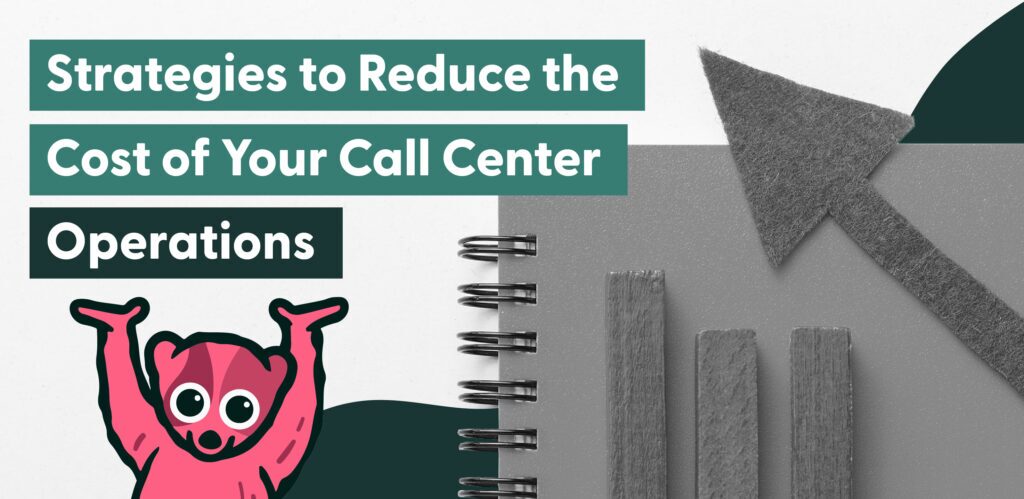
Your call center is the heart of your business. It’s one of the ways your customers interact with your brand directly, and the service you provide has a huge impact on your overall customer experience.
However, running a call center is expensive. For small businesses, a call center of just four people can cost more the $250,000 per year on average. And while there are economies of scale when it comes to technology and office space, most enterprise businesses are still looking at hundreds if not thousands of reps and potentially millions spent on their call center.
Whichever size business you have, if you’re looking for ways to reduce your call center costs, you’ve come to the right place! In this article, we’ll guide you through eight strategies you can implement to lower your call center expenses and still maintain a high customer service quality.
Why You Should Reduce Your Call Center Costs

Besides the obvious need to save money, there are several reasons why reducing your call center costs is beneficial:
✔️ Enhanced profit margins: Improving your operational efficiency and resource allocation will naturally increase your profit margin, meaning you spend less to get them same or better results.
✔️ Scalability: Optimizing call center costs enables you to scale your customer support operations as your business grows without significantly increasing your overhead. For example, if you start using a cloud-based call center platform technology to optimize your call center, you’ll only pay for usage instead of having fixed hardware costs, making it easier to handle fluctuating call volumes without increasing your operational costs.
✔️ A competitive edge: Businesses that reduce unnecessary costs can pass on savings to customers, offer better service, or invest in improvements, gaining a competitive advantage.
✔️ Improved customer experience: Streamlining your call center operations results in faster response times and better customer service, which can help to improve customer satisfaction.
An IT call center called ABC found that lowering its operational costs actually reduced wait times, its staffing-to-call volume ratio, and increased account growth. This helped improve metrics such as their customer satisfaction (CSAT) scores, support casts per call, service time, and their number of transfers.
Strategies to Reduce the Cost of Your Call Center Operations
Now that you know why call centers should reduce their operating costs, let’s look at some strategies you can implement to reduce your own expenses:
1. Leverage artificial intelligence (AI) and self-service options
Customers love to self-serve. In fact, over 67% of customers prefer using self-service options rather than talking to call center agents.
Self-service support options like artificial intelligence (AI) powered chatbots can help you handle common customer inquiries and complaints without them reaching your call center. Over 50% of consumers like to use chatbots because they answer basic questions quickly.
Implementing a chatbot means you’ll likely get fewer calls with basic inquiries coming into your contact center, reducing staffing requirements, meaning lower costs.
For example, let’s say you’re a mobile service provider and see that many customers are calling your support team to ask to have their partner added to their account. You can develop a self-service solution that allows them to do this themselves. This should reduce the number of calls you get, lowering your cost per call.
However, be mindful about how you implement self-service options like chatbots. While they help you handle more common questions and issues, they shouldn’t replace call center agents for more complex inquiries.
2. Use automated or skill-based call routing
Manual call routing is a process where call center agents or operators manually direct incoming calls to the appropriate department, agent, or service. This process requires human intervention to assess the customer’s needs and determine who is best suited to handle their issue.
Manual call routing is significantly expensive for call centers as it increases:
❌ The demand for additional staff to route calls.
❌ Handling times.
❌ The risk of misrouting calls.
Intelligent call routing strategies, such as predictive behavioral routing, use algorithms to route incoming calls based on the customer’s location, interaction history, and past behavior.
Another option is implementing interactive voice response (IVR) call center software. In this system, customers first engage with an automated menu and can choose options related to their question or issue. The technology then automatically routes them to the appropriate agent. Using IVR can cost 48 times less than manual call routing.
Connecting customers with the right agents eliminates the need for call transfers and escalations that will likely frustrate your customers.
Doing this can also increase your first call resolution (FCR) rates, reduce average handle time (AHT), and improve customer satisfaction. These metrics directly correlate with call center cost reduction.
Identify root causes to boost efficiency
Finding the root cause behind why customers contact your call center helps you reduce operational costs. It enables you to fix these issues before they make contact and reduce the number of calls you receive.
Let’s say your customers call in because they are confused by your product documentation and struggling to find the answers they need. Your complex documentation is the root cause of all these calls. You can fix this issue by providing your customers with easy access to:
ℹ️ Detailed FAQs and intuitive support centers.
ℹ️ Step-by-step guides and self-service tools.
ℹ️ Chatbots and automated resolution built from knowledge of root cause.
If customers can access these help options, they’ll find the answers they need without contacting your call center, reducing the number of calls you receive and your operational costs.
🤔 How Can I Identify the Root Cause of Customer Issues?
Loris is an AI conversation intelligence platform that analyzes every customer interaction in your call center to identify both the reason the customer contacted you as well as the root cause that triggered the issue in the first place.
By providing you with real-time actionable insights, you can spot root causes immediately and take steps to resolve them before they become a more significant issue and result in additional calls.
3. Focus on the right metrics
You can decrease your call center costs by continuously measuring your customer service metrics and key performance indicators (KPIs). Here are some metrics to focus on if you want to reduce your operating costs:
📈 First call resolution (FCR) rate: When you resolve customer issues during your first interaction with them, it reduces the number of repeat calls you receive, escalations, and inbound call volume. You’ll also naturally improve customer satisfaction and reduce your cost per call. A 1% improvement in FCR reduces call center costs by 1%.
📈 Average handle time (AHT): A shorter AHT means your agents can handle more calls in less time, also reducing your cost per call. One way to reduce AHT is by providing agents with extensive knowledge bases where they can find the necessary information to resolve customer issues faster.
📈 Agent occupancy rate: This is the percentage of time agents spend on active calls or performing call-related tasks compared to their available working time. Increasing this metric improves how you use your resources and lowers your call center costs. The best way to achieve this is to remove unnecessary steps agents must take to do their work and by automating your call center processes and workflows.
4. Reduce your call center agent turnover
Hiring, onboarding, and training new call center agents is far more expensive than retaining them. In fact, it costs businesses between $18,500 and $74,000 to replace a call center agent.
When agents leave your call center, it disrupts your operations and creates a gap in staffing which can lead to longer wait and call handling times, resulting in customer dissatisfaction and churn.
One way you can retain agents is by providing them with regular training and development programs. In fact, one major publisher was able to reduce their call center operating costs by more than 50%—saving over $1 million per year—because they focused on providing their agents with excellent coaching and training programs.
Other ways to reduce agent turnover include offering:
👉 Career development opportunities: Providing clear pathways for advancement, such as leadership roles or specialized positions, can increase agent engagement and loyalty. Agents who see a future with your company will likely stay with you.
👉 Competitive compensation and benefits: Fair wages, performance bonuses, and benefits like health insurance can make agents feel valued and reduce the temptation to leave for a higher-paying job elsewhere.
👉 A positive work environment: Encouraging a supportive and collaborative culture, recognizing employee achievements, and promoting work-life balance can significantly improve job satisfaction.
👉 Regular feedback and support: Offering constructive feedback, mentoring, and support helps agents grow in their roles. Regular check-ins also allow for identifying and addressing any concerns early.
Another way to reduce call center agent turnover is to test and screen candidates before hiring them.
A company called Heartland ECSI had a call center agent turnover rate of about 75% (the average is about 30 to 45%), resulting in exceptionally high operating costs.
As a solution, the company decided to implement a type of test when recruiting new agents to identify candidates with the right aptitude, personality, and skills for their call center. After doing so, they reduced their turnover rate to 26% and have seen an 82% improvement in retention.
5. Onboard your agents effectively
One study found that a strong onboarding process can improve employee productivity by as much as 70%. Improved agent productivity has a direct impact on your call center costs.
Proper onboarding and training provide agents with the knowledge and tools they need to handle customer inquiries and issues effectively from day one. This reduces ramp-up time, which is the amount of time it takes for new hires to reach full productivity. It also minimizes the costs associated with unproductive work and mistakes during the learning phase.
Effective onboarding equips agents with problem-solving skills and product knowledge, improving FCR rates and reducing AHT. As mentioned earlier, improving these metrics has a direct impact on call center cost savings.
Additionally, properly trained agents are more likely to provide excellent customer service, leading to higher customer satisfaction and loyalty.
Satisfied customers are less likely to call back with complaints or escalate issues, which helps reduce call volumes. Happy customers are also more likely to stay with your business, reducing the costs of customer churn and acquisition.
6. Take your call center remote
Switching from an in-person call center to a remote operation can lead to significant cost savings for your business. Companies that allow remote work save around $11,000 per employee per year and can reduce call center costs by 27%.
Remote call centers eliminate the need for physical office space, utilities, and equipment maintenance. This can lead to significant overhead reductions, allowing you to invest your resources in other areas of your business, like customer acquisition and growth.
With a remote setup, you aren’t limited by geography. You can hire talented agents from anywhere in the world, which could lead to better customer service quality and the ability to offer 24/7 support across different time zones.
Remote work also offers agents more flexibility for your agents, which may lead to higher job satisfaction and better work-life balance, reducing call center agent turnover. Working remotely can improve agent productivity, as more than 70% of employees report feeling more productive when working remotely.
Additionally, a remote call center can be scaled up or down more easily. So, if demand increases, you can quickly hire additional remote agents without worrying about space constraints or purchasing additional equipment. And with the proper quality assurance program in place, you can maintain quality without being in the same room.
Like what you’re reading? Get the latest news and product updates delivered to you in our newsletter.
7. Outsource your call center
If your call volumes fluctuate or you’re running a small business, it might make better financial sense to outsource your call center to a third party.
More than 54% of companies rely on third-party providers for their customer service operations, and for good reason.
Typically, outsourced call centers already have:
✅ Established infrastructure.
✅ A skilled talent pool.
✅ An efficient hiring process.
✅ Extensive training programs.
When you outsource your call center, none of these factors are your responsibility, saving you money and resources.
Outsourcing also allows you to tap into lower-cost labor markets, often in regions with lower wage expectations. This is especially beneficial if you’re located in a high-cost region.
When you outsource your call center operations, you no longer need to provide employee benefits such as health insurance, paid time off, or retirement plans, as your outsourced provider covers these costs.
Naturally, outsourcing eliminates the need for physical office space, furniture, utilities, and call center equipment, which can be a massive cost saving for your business.
Outsourcing providers can quickly scale their team up or down to match your call volume fluctuations, such as during seasonal peaks or promotional campaigns. This allows you to only pay for the services you need and avoid the fixed costs of maintaining a large, in-house staff year-round.
⚖️ Find the Balance Between Call Center Cost Reduction and Maintaining Service Quality
While the benefits of reducing your call center costs are clear, you shouldn’t sacrifice the quality of the customer service you provide to cut down on expenses.
You may want to reduce costs to improve your profit margin, but you should still aim to provide the best possible customer experience.
For example, you don’t want to improve your FCR drastically by cutting costs if it means that customer issues aren’t being handled effectively from start to finish.
The Right Platform for Call Center Cost Savings
Setting up and running a call center can be a significant expense for your business. Reducing these costs can boost your profit margin, improve the customer experience, and allow you to scale your business without increased overheads.
One platform that can help you identify both inefficiencies and opportunities in your call center that could help you save money is Loris.
Our conversation intelligence platform analyzes all your customer interactions to help your call center managers and quality assurance (QA) analysts identify patterns in your data. This can help you spot root causes and inefficiencies that can be fixed to optimize your call center and your entire business.
Loris also helps you improve your call center costs by providing you with actionable insights that you can use to prevent excessive calls from coming into your contact center.
Speak to a Loris expert today to discover how our AI-powered platform can help you reduce call center costs while maintaining customer satisfaction.
